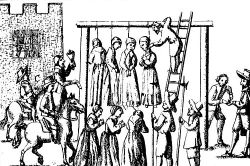Sodom: Difference between revisions
No edit summary |
No edit summary |
||
| Line 27: | Line 27: | ||
==Sodomy laws in the Modern Era | ==Sodomy laws in the Modern Era == | ||
===Early modern era (16th, 17th and 18th centuries)=== | ===Early modern era (16th, 17th and 18th centuries)=== | ||
An examination of trials for rape and sodomy during the 18th century at the Old Bailey in London shows that the treatment of rape was often lenient, while the treatment of sodomy was often severe. However, the difficulty of proving that penetration and ejaculation had occurred meant that men were often convicted of the lesser charge of 'assault with sodomitical intent', which was not a capital offence.<ref>[http://www.oldbaileyonline.org/static/Crimes.jsp#assaultwithsodomiticalintent Crimes tried at the Old Bailey], ''Proceedings of the Old Bailey'' online</ref> | An examination of trials for rape and sodomy during the 18th century at the Old Bailey in London shows that the treatment of rape was often lenient, while the treatment of sodomy was often severe. However, the difficulty of proving that penetration and ejaculation had occurred meant that men were often convicted of the lesser charge of 'assault with sodomitical intent', which was not a capital offence.<ref>[http://www.oldbaileyonline.org/static/Crimes.jsp#assaultwithsodomiticalintent Crimes tried at the Old Bailey], ''Proceedings of the Old Bailey'' online</ref> | ||
Revision as of 17:33, 30 July 2022
Sodom was a legendary (possibly fictional) ancient city located in the Middle East. The exact whereabouts of the city are unknown but it was possibly in geographic proximity to the Dead Sea.[1] The area of the Dead Sea borders Jordan to the east and Israel and the West Bank to the west. It lies in the Jordan Rift Valley, and its main tributary is the Jordan River. [2]

History
In the biblical Sodom and Gomorrah mythology, both cities were destroyed by “sulfur and fire” by God because of their "wickedness" [3] It has been theorized that if the story does have a historical basis and that the cities were likely destroyed by a natural disaster. One such idea is that the Dead Sea was devastated by an earthquake between 2100 and 1900 BCE. This might have unleashed showers of steaming tar[4] or the petroleum and gases existing in the area may have ignited and possibly contributed to the imagery of “brimstone and fire” that accompanied the geological upheaval that destroyed the cities.[1]
There is much disagreement between the different sects and the three major religions of Judaism, Christianity and Islam as to the "sin" of Sodom and Gomorrah ranging from inhospitality to homosexuality.[5] These debates are irreverent and produce few positive results. What is not inconsequential is how the mythology of Sodom and Gomorrah has been used in the past and is currently being used as justification to persecute and even murder people, especially by fundamentalist and extremist Christians and Muslims. [6][7]
Sodomy
Sodomy is primarily used to describe anal sex (commonly know as butt-fucking) but may also be oral sex or sexual activity between a person and a non-human animal (bestiality), or any non-procreative sexual activity.[8][9][10] Originally, the term sodomy, which is derived from the story of Sodom and Gomorrah in the Book of Genesis,[11] was commonly restricted to anal sex.[12][13] The main use of this word was in the persecution of homosexuals, boylovers and others and lead to the advent of "Sodomy laws" used to criminalized sexual behaviors linked to homosexuality.[13][14] In the Western world, many of these laws have been overturned or are not routinely enforced. However in the United States many of these laws remain on the books and there had been a recent push by conservatives to nullify Federal prohibitions on these laws.
Sodomite
Sodomite is a word that was historically used to label gay men and Boylovers, particularly in the middle ages ( 5th to the late 15th) and into the Renaissance (the 15th and 16th centuries) and before the advent of the word homosexual in 1868. "The earliest surviving use of the word "sodomite" used in a sexual sense may be an exchange of letters in 395 C. E. between Saint Jerome and a priest named Amandus, who asks for advice on how to deal with a woman who has left her husband because he was "an adulterer and a sodomite." [15]
Sodomy laws
While sodomy laws may be enforced against anyone deemed to be immoral, they are primary intended/enacted to promote the persecution and to punish homosexuals, Boylovers, and other sexual and gender minorities.
Sodomy laws in the Middle Ages (from the collapse of Roman civilization in the 5th century CE to the period of the Renaissance)
Sodomy laws in the Renaissance (the 13th, 14th, or 15th century)
Sodomy laws in the Modern Era
Early modern era (16th, 17th and 18th centuries)
An examination of trials for rape and sodomy during the 18th century at the Old Bailey in London shows that the treatment of rape was often lenient, while the treatment of sodomy was often severe. However, the difficulty of proving that penetration and ejaculation had occurred meant that men were often convicted of the lesser charge of 'assault with sodomitical intent', which was not a capital offence.[16]
In France in the 18th century, sodomy was still theoretically a capital crime, and there are a handful of cases where sodomites were executed. However, in several of these, other crimes were involved as well. Records from the Bastille and the police lieutenant d'Argenson, as well as other sources, show that many who were arrested were exiled, sent to a regiment, or imprisoned in places (generally the Hospital) associated with moral crimes such as prostitution. Of these, a number were involved in prostitution or had approached children, or otherwise gone beyond merely having homosexual relations. Ravaisson (a 19th-century writer who edited the Bastille records) suggested that the authorities preferred to handle these cases discreetly, lest public punishments in effect publicize "this vice".
Periodicals of the time sometimes casually named known sodomites, and at one point even suggested that sodomy was increasingly popular. This does not imply that sodomites necessarily lived in security - specific police agents, for instance, watched the Tuileries, even then a known cruising area. But, as with much sexual behaviour under the Old Regime, discretion was a key concern on all sides (especially since members of prominent families were sometimes implicated) - the law seemed most concerned with those who were the least discreet.

In 1730, there was a wave of sodomy trials in the Netherlands; some 250 men were summoned before the authorities; 91 faced decrees of exile for not appearing. At least 60 men were sentenced to death.[17]
The last two Englishmen that were hanged for sodomy were executed in 1835. James Pratt and John Smith died in front of Newgate Prison in London on 27 November of that year.[18][19] They had been prosecuted under the Offences against the Person Act 1828, which had replaced the 1533 Buggery Act.
Modern Era (1800 to present)
United States
In the 1950s, all states had some form of law criminalizing sodomy, and in 1986 the United States Supreme Court ruled that nothing in the United States Constitution bars a state from prohibiting sodomy. However, state legislators and state courts had started to repeal or overturn their sodomy laws, beginning with Illinois in 1961, and thus in 2003, only 10 states had laws prohibiting all sodomy, with penalties ranging from 1 to 15 years imprisonment. Additionally, four other states had laws that specifically prohibited same-sex sodomy.
On June 26, 2003, the U.S. Supreme Court in a 6–3 decision in Lawrence v. Texas struck down the Texas same-sex sodomy law, ruling that this private sexual conduct is protected by the liberty rights implicit in the due process clause of the United States Constitution, with Sandra Day O'Connor's concurring opinion arguing that they violated equal protection. This decision invalidated all state sodomy laws insofar as they applied to noncommercial conduct in private between consenting civilians and overruled its 1986 ruling in Bowers v. Hardwick which upheld Georgia's sodomy law.
In the U.S. military, the United States Army Court of Criminal Appeals has ruled that the Lawrence v. Texas decision applies to Article 125 of the Uniform Code of Military Justice, the statute banning sodomy. In United States v. Stirewalt:
CRAWFORD, Chief Judge (concurring in part and in the result): I agree with the result in this case but I "would reserve for another day the questions of whether and how Lawrence [v. Texas, 539 U.S. 558 (2003)] applies to the military. "1 Like United States v. Marcum, "the factual differences between Lawrence and Appellant's case are striking" for the reasons mentioned by the majority as well as the circumstances surrounding the charges themselves.[20]
Stirewalt's conviction of sodomy stood due to the circumstances surrounding the crime. The court went on to say that despite Lawrence's application to the military, Article 125 can still be upheld in cases where there are "factors unique to the military environment" which would place the conduct "outside any protected liberty interest recognized in Lawrence."[21] Examples of such factors could be fraternization, public sexual behavior, or any other factors that would adversely affect good order and discipline. United States v. Meno and United States v. Bullock are two known cases in which consensual sodomy convictions have been overturned in military courts under the Lawrence precedent.[22]
See also
References
- ↑ 1.0 1.1 https://www.britannica.com/place/Sodom-and-Gomorrah/Religious-views
- ↑ https://en.wikipedia.org/wiki/Dead_Sea
- ↑ Genesis 19:24
- ↑ Isbouts, Jean-Pierre (2007). The Biblical World: An Illustrated Atlas. National Geographic Books. p. 71. ISBN 978-1-4262-0138-7. https://books.google.com/books?id=UTEQRDWYJ0kC&pg=PR57.
- ↑ https://www.str.org/w/what-was-the-sin-of-sodom-and-gomorrah-1
- ↑ https://www.hrw.org/report/2022/01/26/even-if-you-go-skies-well-find-you/lgbt-people-afghanistan-after-taliban-takeover
- ↑ https://www.newsweek.com/pastor-gay-people-solution-killings-bible-1714037
- ↑ Shirelle Phelps (2001). World of Criminal Justice: N-Z. Gale Group. p. 686. ISBN 0787650730. https://books.google.com/books?id=izwvAQAAIAAJ&q=World+of+Criminal+Justice:+N-Z.&dq=World+of+Criminal+Justice:+N-Z.&hl=en&sa=X&ei=kx3UUp3gMJGqqQH32YDACw&ved=0CEIQ6AEwAA. Retrieved on January 13, 2014.
- ↑ John Scheb, John Scheb, II (2013). Criminal Law and Procedure. Cengage Learning. p. 185. ISBN 128554613X. https://books.google.com/books?id=VZoWAAAAQBAJ&pg=PA185&dq=&hl=en&sa=X&ei=eB7UUsnOCYqjrgHB9oDADQ&ved=0CEEQ6AEwAw#v=onepage&q=&f=false. Retrieved on January 13, 2014.
- ↑ David Newton (2009). Gay and Lesbian Rights: A Reference Handbook, Second Edition. ABC-CLIO. p. 85. ISBN 1598843079. https://books.google.com/books?id=gjcUFK4RZNcC&pg=PA85&dq=&hl=en&sa=X&ei=-xzUUoveD8GbrgGsuIHIDQ&ved=0CDMQ6AEwAQ#v=onepage&q=&f=false. Retrieved on January 13, 2014.
- ↑ J. D. Douglas, Merrill C. Tenney (2011). Zondervan Illustrated Bible Dictionary. Zondervan. pp. 1584 pages. ISBN 0310492351. https://books.google.com/books?id=8Tq7UcPMwacC&pg=PT3169&dq=&hl=en&sa=X&ei=P3Q-UpHVB4SW2AW_yoH4BA&ved=0CDoQ6AEwAA#v=onepage&q=&f=false. Retrieved on September 21, 2013.
- ↑ Nicholas C. Edsall (2006). Toward Stonewall: Homosexuality and Society in the Modern Western World. University of Virginia Press. pp. 3–4. ISBN 0813925436. https://books.google.com/books?id=0qjwZeKNyh4C&pg=PA3&dq=&hl=en&sa=X&ei=fmY-UrL3K6TC2QXS-YDoBQ&ved=0CDgQ6AEwAjgU#v=onepage&q=&f=false. Retrieved on September 21, 2013.
- ↑ 13.0 13.1 Colin Sumner (2008). The Blackwell Companion to Criminology. John Wiley & Sons. pp. 310–320. ISBN 0470998954. https://books.google.com/books?id=seDrXjekCWwC&pg=PA311&dq=&hl=en&sa=X&ei=cm0-UrmQGsHh2AXAvYHoAg&ved=0CFYQ6AEwCDgK#v=onepage&q=&f=false. Retrieved on September 21, 2013.
- ↑ Andrew Sullivan (March 24, 2003). Unnatural Law. The New Republic. Retrieved on November 27, 2009. “Since the laws had rarely been enforced against heterosexuals, there was no sense of urgency about their repeal.” (Or Sullivan, Andrew (2003-03-24). "Unnatural Law". The New Republic 228 (11).)
- ↑ https://web.archive.org/web/20080704144443/http://www.glbtq.com/social-sciences/sodomy.html
- ↑ Crimes tried at the Old Bailey, Proceedings of the Old Bailey online
- ↑ Rictor Norton, The Dutch Purge of Homosexuals 1730
- ↑ See
- ↑ Alternative date April 8, 1835 seen 2012 Archived November 20, 2012, at the Wayback Machine
- ↑ U.S. v. Stirewalt
- ↑ U.S. v. Marcum
- ↑ United States v. Meno, United States Court of Criminal Appeals Archived 2008-02-27 at the Wayback Machine
External links
- For more on the religious mythology see: Sodom and Gomorrah (Wikipedia)